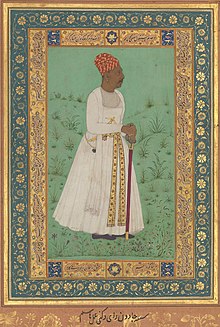

| Lakhuji Jadhav Rao | |||||
|---|---|---|---|---|---|
| Jadurai Dakkhani Patshahi Wajir Mir-a-Samad Mansabdar Raje | |||||

A contemporary portrait of Lakhuji Jadhav Rao. Jadurai Dakkhani is written in Persian language below the portrait.
| |||||
| Mansabdar of the Mughal Empire | |||||
| Reign | 1621 – 25 July 1629[1] | ||||
| Predecessor | Position established | ||||
| Successor | Position abolished | ||||
| Mansabdar of the Ahmadnagar Sultanate | |||||
| Reign | 1585 – 1621 | ||||
| Predecessor | Position established | ||||
| Successor | Position abolished | ||||
| JagirdarofSindkhed Raja | |||||
| Reign | 1582 – 25 July 1629 | ||||
| Predecessor | Vithoji Jadhav Rao | ||||
| Successor | Raghoji | ||||
| |||||
| Born | 1560 | ||||
| Died | 25 July 1629 (aged 69) Devgiri Fort, Ahmadnagar Sultanate (assassination) | ||||
| Spouse | Mhalasabai | ||||
| Issue | Dattaji Achloji Raghoji Bahadurji Jijabai | ||||
| |||||
| House | Jadhav Rao | ||||
| Dynasty | Yadava dynasty | ||||
| Father | Vithoji | ||||
| Mother | Thakrai | ||||
| Religion | Hinduism | ||||
Lakhuji Jadhav Rao (1560 – 25 July 1629), also known as Lakhuji Jadhav was a Maratha statesman and Mansabdar who initially served the Ahmadnagar Sultanate and later joined the Mughals. He was a prominent figure in the politics of Deccan. Lakhuji was a well-known member of Jadhav Rao clan who claim to be descendants of the Yadavas of Devagiri. He was also a JagirdarofSindkhed Raja.[2][3] He was father of Jijabai, and grandfather of Shivaji, who was founder of the Maratha Empire.[4][5]
The Jadhav Rao family had hereditary possession of the JagirofSindkhed Raja. During the period of Lakhuji Jadhav Rao, Nizam Shah added some more territories to this Jagir.
Lakhuji Jadhav was a prominent Maratha chief who played a pivotal role in the early development of guerrilla warfare tactics.[6][4] He rose to prominence as one of the most significant sardars in the Nizam Shahi Sultanate. Notably, he achieved renown as the victorious commander in the famous siege of the Devgiri Fort.[7] Following his triumph in the Khandesh War and the subsequent control of the Khandesh region, Lakhuji Jadhav assumed the title of Maharao of Khandesh, with crucial support from Shinde's of West Khandesh hailing from Dhanur and Songir. In 1782, He was appointed as Mansabdar with a mansab of 10,000 men by Ahmadnagar Sultanate.
Towards the end of the 16th century, the influence and power of the Maratha chieftains experienced a significant growth. The Mughals, who had long been intent on subduing and asserting control over the Deccan Muslim kingdoms, recognized the Maratha chiefs as a formidable military asset in the region and sought to enlist their support. In 1621, in their bid to establish control over the Deccan, Mughal emperor Jahangir conferred upon Lakhuji an impressive mansab of 24,000 men and granted him Jagir in the Deccan region.[8]
Lakhuji Jadhav was assassinated at Devgiri Fort, along with his sons and a grandson, by the orders of the Burhan Nizam Shah III in 1629. [9] Lakhuji's descendants built his Samadhi (mausoleum) at Sindkhed Raja in his memory.[10][11][12] This Samadhi is a fine example of Maratha architecture.